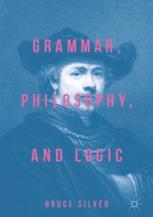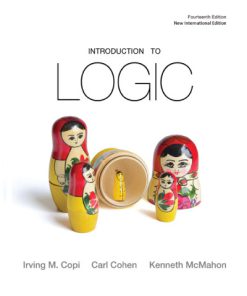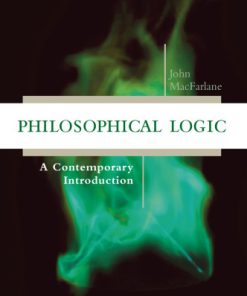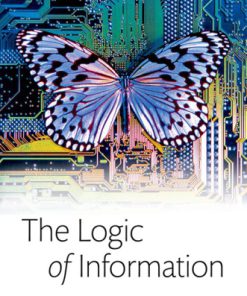Logic Philosophy A Modern Introduction 13th Edition by Howard Kahane,Alan Hausman,Frank Boardman 9781624669354 1624669352
$50.00 Original price was: $50.00.$25.00Current price is: $25.00.
Logic Philosophy A Modern Introduction 13th Edition by Howard Kahane,Alan Hausman,Frank Boardman – Ebook PDF Instant Download/Delivery:9781624669354,1624669352
Full download Logic Philosophy A Modern Introduction 13th Edition after payment
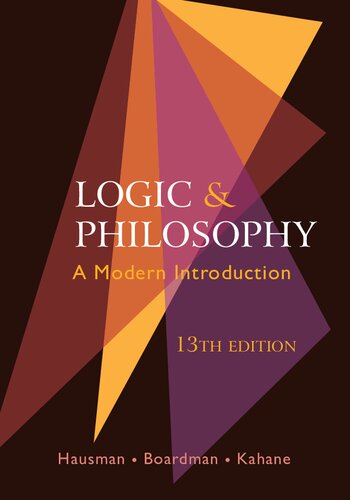
Product details:
ISBN 10:1624669352
ISBN 13:9781624669354
Author:Howard Kahane,Alan Hausman,Frank Boardman
A comprehensive introduction to formal logic, Logic and Philosophy: A Modern Introduction is a rigorous yet accessible text, appropriate for students encountering the subject for the first time. Abundant, carefully crafted exercise sets accompanied by a clear, engaging exposition build to an exploration of sentential logic, first-order predicate logic, the theory of descriptions, identity, relations, set theory, modal logic, and Aristotelian logic. And as its title suggests, Logic and Philosophy is devoted not only to logic but also to the philosophical debates that led to the development of the field. Much new material has been added for the 13th edition. An introduction to set theory and its relationship to logic and mathematics, including philosophical issues, is now part of Chapter 13. Chapter 15 is an introduction to modal logic and Kripke semantics, concluding with a discussion of philosophical problems with any logical accommodation of modalities. Instructors who do not wish to present proof methods will find chapters on truth trees for both sentential and first-order logic, and a presentation of trees for modal logic.
Special features of this text include presentations of the history of logic, alternatives to traditional methods of conditional and indirect proof, and a discussion of semantic problems with universal and existential instantiations. Throughout, the authors are sensitive to philosophical issues that arise from the relationship between ordinary language, symbolic logic, and justifications for the syntax and semantics of the various symbolic languages. Discussions range from the justification of the truth table for the sentential rendering of if . . . then statements to semantic and syntactic paradoxes, including some troubling paradoxes that arise in ordinary language (e.g., the so-called hangman or surprise quiz paradox).
Logic and Philosophy includes ample material for a one-semester or two-semester course and provides a thorough preparation for more advanced logic courses.
Logic Philosophy A Modern Introduction 13th Table of contents:
Chapter One: Introduction
1 The Elements of an Argument
2 Deduction and Induction
3 Deductive Argument Forms
4 Truth and Validity
5 Soundness
6 Consistency
7 Contexts of Discovery and Justification
8 The Plan of This Book
Part One: Sentential Logic
Chapter Two: Symbolizing in Sentential Logic
1 Atomic and Compound Sentences
2 Truth-Functions
3 Conjunctions
4 Non–Truth-Functional Connectives
5 Variables and Constants
6 Negations
7 Parentheses and Brackets
8 Use and Mention
9 Disjunctions
10 “Not Both” and “Neither . . . Nor”
11 Material Conditionals
12 Material Biconditionals
13 “Only If” and “Unless”
14 Symbolizing Complex Sentences
15 Alternative Sentential Logic Symbols
Chapter Three: Truth Tables
1 Computing Truth-Values
2 Logical Form
3 Tautologies, Contradictions, and Contingent Sentences
4 Logical Equivalences
5 Truth Table Test of Validity
6 Truth Table Test of Consistency
7 Validity and Consistency
8 The Short Truth Table Test for Invalidity
9 The Short Truth Table Test for Consistency
10 A Method of Justification for the Truth Tables
Chapter Four: Proofs
1 Argument Forms
2 The Method of Proof: Modus Ponens and Modus Tollens
3 Disjunctive Syllogism and Hypothetical Syllogism
4 Simplification and Conjunction
5 Addition and Constructive Dilemma
6 Principles of Strategy
7 Double Negation and DeMorgan’s Theorem
8 Commutation, Association, and Distribution
9 Contraposition, Implication, and Exportation
10 Tautology and Equivalence
11 More Principles of Strategy
12 Common Errors in Problem Solving
Chapter Five: Conditional and Indirect Proofs
1 Conditional Proofs
2 Indirect Proofs
3 Strategy Hints for Using CP and IP
4 Zero-Premise Deductions
5 Proving Premises Inconsistent
6 Adding Valid Argument Forms
7 The Completeness and Soundness of Sentential Logic
8 Introduction and Elimination Rules
Chapter Six: Sentential Logic Truth Trees
1 The Sentential Logic Truth Tree Method
2 The Truth Tree Rules
3 Details of Tree Construction
4 Normal Forms and Trees
5 Constructing Tree Rules for Any Function
Part Two: Predicate Logic
Chapter Seven: Predicate Logic Symbolization
1 Individuals and Properties
2 Quantifiers and Free Variables
3 Universal Quantifiers
4 Existential Quantifiers
5 Basic Predicate Logic Symbolizations
6 The Square of Opposition
7 Common Pitfalls in Symbolizing with Quantifiers
8 Expansions
9 Symbolizing “Only,” “None but,” and “Unless”
Chapter Eight: Predicate Logic Semantics
1 Interpretations in Predicate Logic
2 Proving Invalidity
3 Using Expansions to Prove Invalidity
4 Consistency in Predicate Logic
5 Validity and Inconsistency in Predicate Logic
Chapter Nine: Predicate Logic Proofs
1 Proving Validity
2 The Four Quantifier Rules
3 The Five Main Restrictions
4 Precise Formulation of the Four Quantifier Rules
5 Mastering the Four Quantifier Rules
6 Quantifier Negation
Chapter Ten: Relational Predicate Logic
1 Relational Predicates
2 Symbolizations Containing Overlapping Quantifiers
3 Expansions and Overlapping Quantifiers
4 Places and Times
5 Symbolizing “Someone,” “Somewhere,” “Sometime,” and So On
6 Invalidity and Consistency in Relational Predicate Logic
7 Relational Predicate Logic Proofs
8 Strategy for Relational Predicate Logic Proofs
9 Theorems and Inconsistency in Predicate Logic
10 Predicate Logic Metatheory
11 A Simpler Set of Quantifier Rules
Chapter Eleven: Rationale Behind the Precise Formulation of the Four Quantifier Rules
1 Cases Involving the Five Major Restrictions
2 One-to-One Correspondence Matters
3 Accidentally Bound Variables and Miscellaneous Cases
4 Predicate Logic Proofs with Flagged Constants
Chapter Twelve: Predicate Logic Truth Trees
1 Introductory Remarks
2 General Features of the Method
3 Specific Examples of the Method
4 Some Advantages of the Trees
5 Example of an Invalid Argument with at Least One Open Path
6 Metatheoretic Discussion
7 Strategy and Accounting
Chapter Thirteen: Identity, Higher-Order Logics, and Sets
1 Identity
2 Definite Descriptions
3 Properties of Relations
4 Higher-Order Logics
5 Sets and First-Order Predicate Logic
6 Set Theory and Second-Order Predicate Logic
7 Russell’s Paradox
8 Sets in Foundational Arithmetic
9 The Existence of Sets
Chapter Fourteen: Philosophical Problems of Symbolic Logic
1 Limitations of Predicate Logic
2 Philosophical Problems
3 Logical Paradoxes
Chapter Fifteen: Modal Logic
1 Modality and Modal Logics
2 Modal Symbols and Translations
3 Modal Logic Semantics
4 Accessibility
5 Modal Truth Trees
6 Quantified Modal Logic
7 Modal Realism, Modal Fictionalism, and Transworld Identity
8 Applications of Modal Logic
9 Objections to Modal Logic
Chapter Sixteen: Syllogistic Logic
1 Categorical Propositions
2 Existential Import
3 The Square of Opposition
4 Conversion, Obversion, Contraposition
5 Syllogistic Logic—Not Assuming Existential Import
6 Venn Diagrams
7 Syllogisms
8 Determining Syllogism Validity
9 Venn Diagram Proofs of Validity or Invalidity
10 Five Rules for Determining Validity or Invalidity
11 Syllogistics Extended
12 Enthymemes
13 Sorites
14 Technical Restrictions and Limitations; Modern Logic and Syllogistic Logic Compared
Appendix A An Alternative to Conditional Proof?
Appendix B Instantiations and Semantics
Appendix C A Final Note on Translations
Answers to Even-Numbered Exercise Items
People also search for Logic Philosophy A Modern Introduction 13th:
matlab predictive maintenance ebook
predictive maintenance with matlab and simulink from data to deployment
predictive maintenance with matlab a prognostics case study
predictive maintenance with matlab and simulink from data to deployment
mathworks predictive maintenance
Tags:
Howard Kahane,Alan Hausman,Frank Boardman,Introduction,Modern
You may also like…
dictionaries & phrasebooks
Grammar, Philosophy, and Logic 1st Edition Bruce Silver (Auth.)
Politics & Philosophy - General & Miscellaneous Philosophy
Philosophy: A Text with Readings 13th Edition Manuel Velasquez
Business & Economics - Sales & Marketing
Uncategorized
Politics & Philosophy
Computers - Programming
Introduction to Logic Programming 1st Edition by Michael Genesereth 1681737221 9781681737225
Politics & Philosophy - Major Branches of Philosophical Study
Philosophical Logic: A Contemporary Introduction John Macfarlane
Politics & Philosophy - General & Miscellaneous Philosophy




